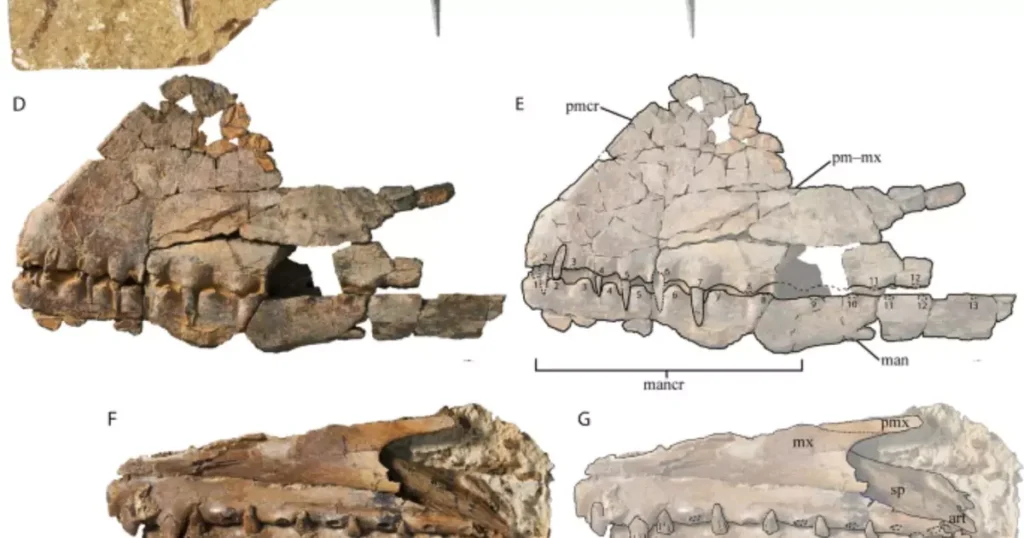Kevin Petersen, in addition to cultivating avocados, serves as the curator of the Kronosaurus Korner fossil museum in northwest Queensland, Australia. In 2021, while pursuing his passion as an amateur paleontologist, Petersen made a remarkable discovery: he unearthed several fossilized bones in western Queensland, unveiling a new species of pterosaur.
Named Haliskia peterseni, this flying reptile was the first known vertebrate to evolve the ability to fly approximately 100 million years ago, coexisting with dinosaurs. With an impressive wingspan of 4.6 meters, this discovery provides new insights into the diversity and evolution of these ancient sky dwellers.

A statement from the team at Curtin University in Perth, which led the research, announced the discovery of a new genus and species of pterosaur, Haliskia peterseni. Published in the journal Scientific Reports, the study detailed that the fossils were found in western Queensland and date back roughly 100 million years. With an estimated wingspan of 4.6 meters, Haliskia is described as a formidable predator that inhabited a region then submerged by a vast inland sea, located where today’s southern Victoria coast lies. Adele Pentland, a doctoral candidate at Curtin’s School of Earth and Planetary Sciences, highlighted the importance of these findings in understanding the diversity and behavior of pterosaurs during the Cretaceous period.
Described as the first vertebrate to develop the ability to fly, Haliskia peterseni lived alongside dinosaurs during the Mesozoic Era, which began around 252 million years ago. Pterosaurs, winged reptiles with skin membrane wings, share some similarities with bats but stand out for their distinctive heads and unique adaptations for flight, as explained by Pentland.
With a wingspan of approximately 4.6 meters, Haliskia was a formidable predator that fed on fish and squid-like cephalopods in the vast inland sea that once covered much of central-western Queensland. This environment was also home to large marine reptiles such as plesiosaurs and ichthyosaurs. According to Pentland, despite its predominantly aquatic life, Haliskia needed to return to land to reproduce—a common behavior among pterosaurs.
These discoveries provide new insights into the ecology and behavior of pterosaurs during the Cretaceous, enriching our understanding of ancient life on Earth.
Pentland noted that Haliskia peterseni faced significant challenges in the marine environment of the Mesozoic Era, potentially falling prey to formidable predators like Kronosaurus, whose skull measured an impressive 2.4 meters in length. “Haliskia would have stood no chance against such a beast,” Pentland commented.
The discovery of Haliskia is particularly significant as fewer than 25 sets of pterosaur remains have been found in Australia since the 1980s, compared to over 100 sets discovered in Brazil and Argentina. The specimen unearthed by Kevin Petersen represents the most complete pterosaur ever found in Australia. Pentland praised Petersen for his meticulous preparation of the fossilized remains.
These findings not only expand our knowledge of ancient biodiversity in Australia but also offer fascinating insights into the interactions between marine predators and flying reptiles that once inhabited the ancient seas covering present-day Queensland.
Pentland emphasized that the fossil of Haliskia peterseni is 22% complete, making it more than twice as complete as the only other partial pterosaur skeleton known from Australia. This specimen includes complete lower jaws, the tip of the upper jaw, 43 teeth, vertebrae, ribs, wing bones, part of a leg, and extremely fine throat bones indicative of a muscular tongue that aided in feeding on fish and cephalopods.
Pentland shared that she did not expect the specimen to be as complete as it turned out to be. The fossil will be added to the collection of Kronosaurus Korner, where Kevin Petersen, its discoverer, expressed his excitement about the significant find.
“I’m thrilled that my discovery is of a new species, as my passion lies in helping to shape our modern understanding of prehistoric species,” Petersen stated in a press release.
Pentland revealed that she will continue collaborating with regional museums in Australia to describe new fossil materials, while also maintaining partnerships with researchers in Brazil.
In a study led by Pentland in May 2023, it was discovered that pterosaurs were already flying over Australia’s skies around 107 million years ago, further expanding our understanding of these ancient creatures’ presence and evolution on the Australian continent.
Paleontologists reached this conclusion after examining two pieces of prehistoric bone extracted from Dinosaur Cove, a fossil-rich site in Victoria, over three decades ago. These samples were identified as the oldest pterosaur remains ever recovered in Australia, as detailed in the study published in the journal Historical Biology.
This discovery marks a significant milestone in Australian paleontology, offering new insights into the evolution of pterosaurs on the continent. The fossil remains from Dinosaur Cove date back over 107 million years, positioning these winged creatures as integral to Australia’s ancient ecosystem during the Cretaceous period.
The research, published in Historical Biology, underscores the critical importance of fossil sites like Dinosaur Cove. These locations not only provide a treasure trove of fossils that help reconstruct Earth’s distant past but also serve as essential reference points for advanced paleontological studies.
Collaboration between scientists and museum institutions plays a vital role in interpreting these discoveries. By combining efforts, experts can not only catalog and describe new fossil materials but also share these findings with the public, enriching the collective understanding of Australia’s natural history.
In addition to revealing the presence of pterosaurs in Australia millions of years ago, these studies highlight the ongoing need to preserve and study fossil sites. Conserving these areas is crucial not only for current science but also for future generations of paleontologists, ensuring they can continue exploring and learning from the remnants of the past still buried beneath our feet.

